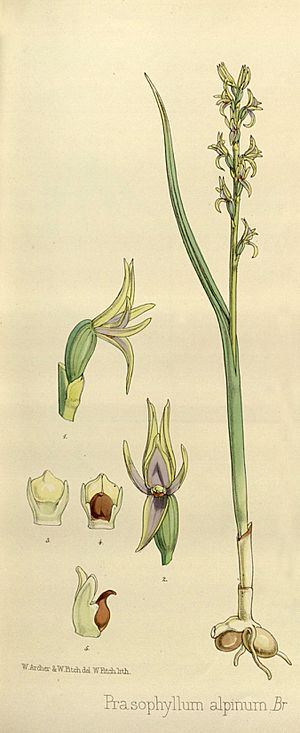Prasophyllum alpinum facts for kids
Quick facts for kids Alpine leek orchid |
|
|---|---|
 |
|
| Scientific classification |
The Prasophyllum alpinum, also known as the alpine leek orchid, is a special type of orchid. It is found only in Tasmania, an island state of Australia. This means it is endemic to Tasmania. People used to think it grew in mainland Australia too, but the Tasmanian version has smaller flowers. This orchid has a single leaf shaped like a tube and grows up to fourteen green or greenish-brown flowers. You can find it growing in cool, high-up areas called subalpine zones.
Contents
What the Alpine Leek Orchid Looks Like
The alpine leek orchid is a plant that grows from the ground. It is a perennial plant, meaning it lives for more than two years. It is also deciduous, so its leaves might die back in some seasons. This plant is a herb, which means it doesn't have a woody stem like a tree. It grows from an underground tuber, which is like a small storage organ.
Leaves and Flowers
Each orchid has one leaf that looks like a tube. This leaf can be about 8 to 20 centimeters (3 to 8 inches) long and 2 to 5 millimeters (0.08 to 0.2 inches) wide. The bottom part of the leaf is white. The top part, which is free from the stem, is about 8 to 12 centimeters (3 to 5 inches) long.
The orchid grows a flowering spike that is about 3 to 10 centimeters (1 to 4 inches) tall. Along this spike, you will find between five and fourteen flowers. These flowers are green to greenish-brown and are about 5 to 8 millimeters (0.2 to 0.3 inches) long. Sometimes, some of the flowers might not open fully.
Flower Structure
Like other orchids in its group, the flowers of the alpine leek orchid are upside down. This means the labellum (a special lip-like petal) is above the column (the central part of the flower) instead of below it.
The top sepal (a leaf-like part that protects the flower bud) is shaped like an egg. It is about 4 to 5 millimeters (0.16 to 0.2 inches) long and about 2 millimeters (0.08 inches) wide. The two side sepals are joined together along their edges. The petals are thin or egg-shaped, about 4 millimeters (0.16 inches) long and 1 millimeter (0.04 inches) wide. The labellum is egg-shaped or broadly spear-shaped. It is about 3 to 4 millimeters (0.12 to 0.16 inches) long and about 2 millimeters (0.08 inches) wide. It can be white or greenish.
Flowering Time
You can see the alpine leek orchid in bloom from December to January. This is during the summer months in Tasmania.
Naming the Alpine Leek Orchid
The alpine leek orchid was first officially described in 1810. A famous botanist named Robert Brown gave it its scientific name, Prasophyllum alpinum. He published his description in a book called Prodromus Florae Novae Hollandiae et Insulae Van Diemen.
Meaning of the Name
The second part of its scientific name, alpinum, is a Latin word. It means "of high mountains." This name fits well because the orchid grows in high, mountainous areas.
Similar Orchids
Some other orchid species were once thought to be the same as P. alpinum. These include Prasophyllum colensoi from New Zealand and P. tadgellianum and P. sphacelatum from mainland Australia. However, scientists later realized they were different species.
Where the Alpine Leek Orchid Lives
The alpine leek orchid is quite common in certain parts of Tasmania. It likes to grow in moist areas, such as grasslands and herbfields. You can find it in places that are higher than 650 meters (2,130 feet) above sea level. These areas are generally south of a famous landmark called Cradle Mountain.

